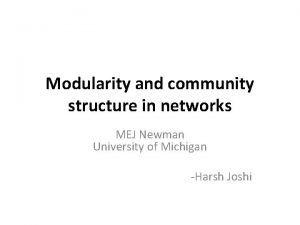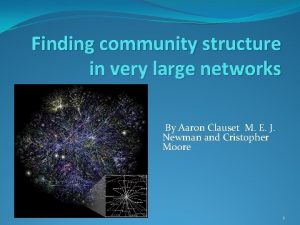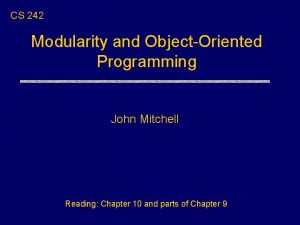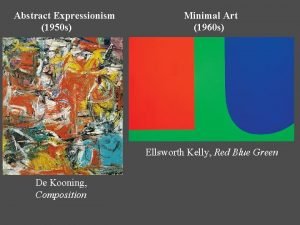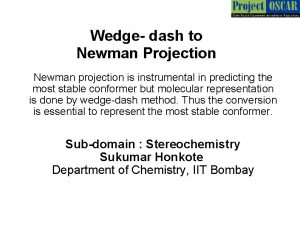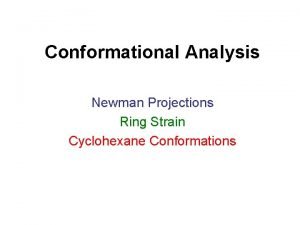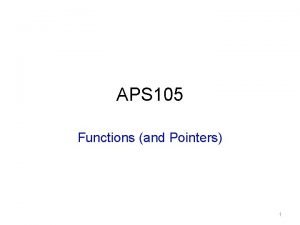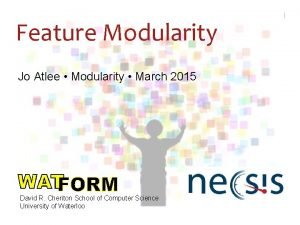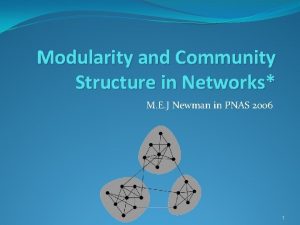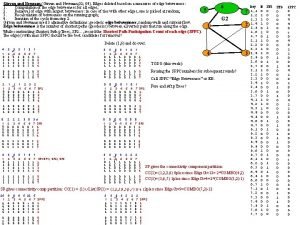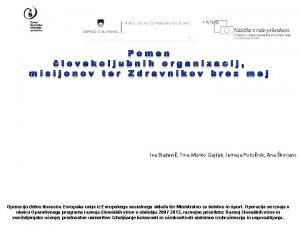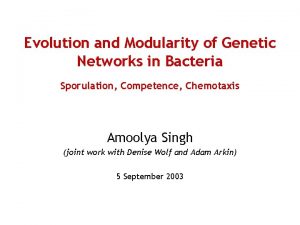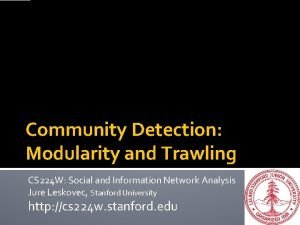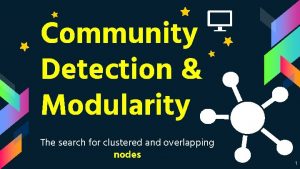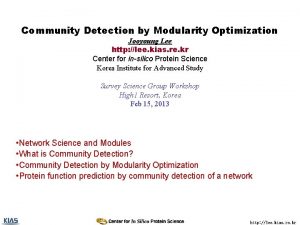Modularity and community structure in networks MEJ Newman



























- Slides: 27

Modularity and community structure in networks MEJ Newman University of Michigan -Harsh Joshi




Pervious Work • Graph Partitioning - Minimum Cuts - Spectral Partitioning • Applications: - Parallel computing - VLSI design and other CAD applications

Pervious Work • Block Modeling or Hierarchical Clustering or Community Structure Detection - Best fits to stochastic models - Hierarchical clustering based on single or average linkage clustering - Betweenness-based Methods

Graph Partitioning • Graph partitioning algorithms are typically based on minimum cut approaches or spectral partitioning :

Spectral bisection Eigen-vectors of the graph Laplacian. L = D-A A is the adjacency matrix D is a diagonal Matrix of vertex degrees • • 1 2 3 4 5 is always eigenvector with eigenvalue 0.

Bisect ! 1 2 3 4 5 The eigenvector corresponding to the lowest eigenvalue must have both positive and negative elements.

Spectral Bisection (Cont. ) • It only bisects graphs into only 2 communities. • Division into a larger number of communities is usually achieved by repeated bisection, but this does not always give satisfactory results. • We do not in general know ahead of time how many communities we want to divide the graph into.

Graph Partitioning • Minimum cut partitioning breaks down when we don’t know the sizes of the groups - Optimizing the cut size with the groups sizes free puts all vertices in the same group • Cut size is the wrong thing to optimize - A good division into communities is not just one where there a small number of edges between groups • There must be a smaller than expected number edges between communities

Modularity Other Approaches: • Greedy Algorithm: Start with all the vertices in separate communities. - Find the two communities whose amalgamation gives the greatest increase in the modularity • Simulated annealing ( Guimera & Amaral 2005) • External Optimization(Dutch & Arenas 2005)

Modularity (Newman and Girvan 2004) Define modularity to be Q = (number of edges within groups) – (expected number within groups). Actual Number of Edges between i and j is Expected Number of Edges between i and j is

Modularity Matrix • So Q is a sum of (si, sj) over pairs (i, j) that are in the same group • Or we can write in matrix form as Where s is a the vector whose elements are si Where B is a new characteristic matrix, the modularity marix,

Modularity Matrix s is the linear combination of the normalized eigenvectors ui of B βi is the eigenvalue of B corresponding to eigenvector ui • We maximize the coefficient on the largest eigenvalue by choosing

Modularity Matrix Algorithm • Calculate the leading eigenvector of the modularity matrix • Divide the vertices according to the signs of the elements Note that there is no need to forbid the solution with all the vertices in a single group.

Example

Spectral properties of modularity matrix • Vector(1, 1, 1, …) is always an eigenvector of B with eigenvalue zero • Eigenvalues can either be positive or negative - So long as there is any positive eigenvalue we will never put all vertices in the same group • But there may be no positive eigenvalues - All vertices in same group gives highest modularity - Such networks are indivisible

Dividing into more than two groups • Repeated division into two groups - Divide into two, then divide those parts into two, etc • Stop when there is no division that will increase the modularity - This is precisely when the subgraph is indivisible - Stop when there are no positive eigenvalues of the modularity matrix

Modularity Matrix • Time Complexity O(n 2 logn) • Better than Betweenness Algorithm O(n 3) External Optimization O(n 2 log 2 n) • Not as good as Greedy Algorithm O(nlog 2 n) but better quality results

Modularity Matrix • Actual Running Time Collaboration network of about 27000 vertices, the algorithm takes around 20 minutes to run on a standard personal computer.


Example Applications • Books on politics The vertices represent 105 recent books sold from Amazon. com Divide the books according to their political alignment Liberal / Conservative / Centrist

Example

Comparison to other methods CN = Betweenness CNM = Greedy DA = External Optimization

Summary • Modularity maximization appears to be a highly competitive approach to community detection in networks • It can be formulated as a spectral optimization problem, which leads to fast and accurate algorithms • There are close connections between the spectrum of the modularity matrix and the community structure

References • Modularity and Community Structure in Networks – MEJ Newman • Detecting community structure in network, M. E. J. Newman. • Finding community structure in very large networks, Aaron Clauset, M. E. J. Newman, and Cristopher Moore.
 Modularity and community structure in networks
Modularity and community structure in networks Finding community structure in very large networks
Finding community structure in very large networks Taxonomy of bugs in stm
Taxonomy of bugs in stm Object oriented programming modularity
Object oriented programming modularity Regularity in vlsi
Regularity in vlsi Datagram vs virtual circuit
Datagram vs virtual circuit Basestore iptv
Basestore iptv Gerald levey and mark newman
Gerald levey and mark newman Gerald levey and mark newman
Gerald levey and mark newman Gerald levey and mark newman
Gerald levey and mark newman Joseph kosuth: one and three chair barnett newman:
Joseph kosuth: one and three chair barnett newman: Cognitive apprenticeship collins brown and newman
Cognitive apprenticeship collins brown and newman Gerald levey and mark newman
Gerald levey and mark newman Wedge vs dash
Wedge vs dash Teoria de taylor
Teoria de taylor Newman projection practice
Newman projection practice What shapes internal structure
What shapes internal structure Margaret newman theory application
Margaret newman theory application Robbins hall plymouth
Robbins hall plymouth Hsc geography syllabus
Hsc geography syllabus Gauche interaction
Gauche interaction Cardinal newman cedar
Cardinal newman cedar Perencanaan menurut newman
Perencanaan menurut newman Newman projection generator
Newman projection generator Barnett newman abraham
Barnett newman abraham Robert c newman ii
Robert c newman ii Colgajo de widman modificado pasos
Colgajo de widman modificado pasos Butano newman
Butano newman
